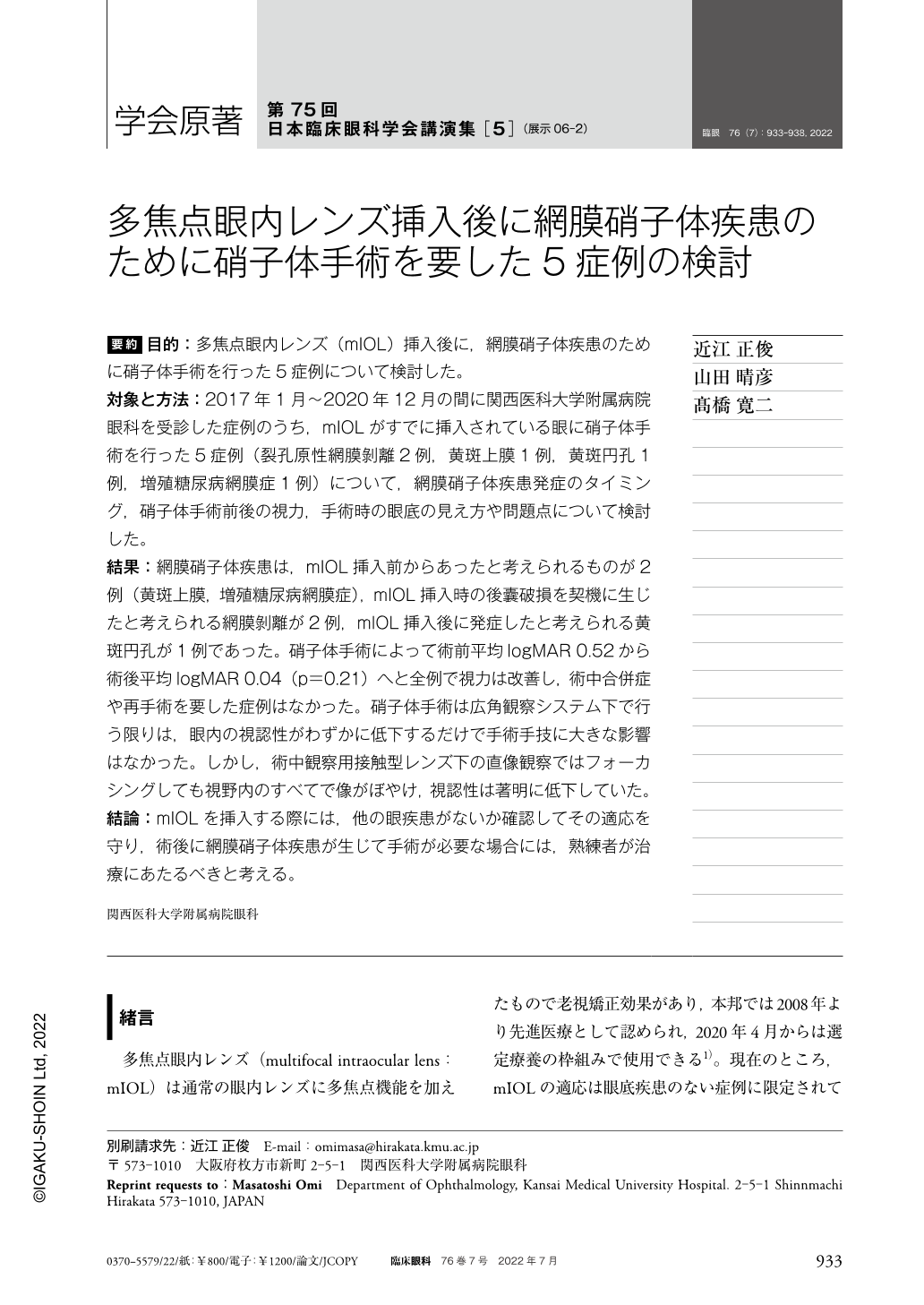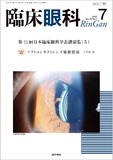Japanese
English
- 有料閲覧
- Abstract 文献概要
- 1ページ目 Look Inside
- 参考文献 Reference
要約 目的:多焦点眼内レンズ(mIOL)挿入後に,網膜硝子体疾患のために硝子体手術を行った5症例について検討した。
対象と方法:2017年1月〜2020年12月の間に関西医科大学附属病院眼科を受診した症例のうち,mIOLがすでに挿入されている眼に硝子体手術を行った5症例(裂孔原性網膜剝離2例,黄斑上膜1例,黄斑円孔1例,増殖糖尿病網膜症1例)について,網膜硝子体疾患発症のタイミング,硝子体手術前後の視力,手術時の眼底の見え方や問題点について検討した。
結果:網膜硝子体疾患は,mIOL挿入前からあったと考えられるものが2例(黄斑上膜,増殖糖尿病網膜症),mIOL挿入時の後囊破損を契機に生じたと考えられる網膜剝離が2例,mIOL挿入後に発症したと考えられる黄斑円孔が1例であった。硝子体手術によって術前平均logMAR 0.52から術後平均logMAR 0.04(p=0.21)へと全例で視力は改善し,術中合併症や再手術を要した症例はなかった。硝子体手術は広角観察システム下で行う限りは,眼内の視認性がわずかに低下するだけで手術手技に大きな影響はなかった。しかし,術中観察用接触型レンズ下の直像観察ではフォーカシングしても視野内のすべてで像がぼやけ,視認性は著明に低下していた。
結論:mIOLを挿入する際には,他の眼疾患がないか確認してその適応を守り,術後に網膜硝子体疾患が生じて手術が必要な場合には,熟練者が治療にあたるべきと考える。
Abstract Purpose:We reviewed five cases of vitrectomy for vitreoretinal diseases after implantation of multifocal intraocular lenses(mIOL).
Cases and Methods:We retrospectively reviewed the patients who visited the Department of Ophthalmology, Kansai Medical University Hospital between January 2017 and December 2020. Among them, five cases had undergone vitreous surgery performed on eyes in which mIOL had already been implanted(two cases of rhegmatogenous retinal detachment, one case of epiretinal membrane, one case of macular hole, and one case of proliferative diabetic retinopathy). We examined the timing of the onset of vitreoretinal disease, visual acuity before and after vitrectomy, and fundus visibility and problems at the time of surgery for these five cases.
Results:The timing of the onset of vitreoretinal disease were as follows:two patients had vitreoretinal disease before mIOL implantation(epiretinal membrane, proliferative diabetic retinopathy), two patients had retinal detachment caused by posterior capsule damage during mIOL implantation, and one patient developed macular hole after mIOL implantation. Visual acuity improved in all patients(mean preoperative logMAR 0.52 to mean postoperative logMAR 0.04, p=0.21), and no intraoperative complications or cases requiring reoperation ocurred. As long as the vitrectomy was performed under the wide-angle viewing system, the intraocular visibility was slightly reduced but did not affect any surgical procedures. However, when the vitrectomy was performed using the direct-image viewing system under the contact lens, the visibility was markedly reduced as if no part of the field of view was in focus.
Conclusions:We recommend not to use mIOL in eyes with vitreoretinal disease. However, if vitreoretinal disease occurs postoperatively and requires surgery, skilled surgeons should be involved in the treatment.

Copyright © 2022, Igaku-Shoin Ltd. All rights reserved.


